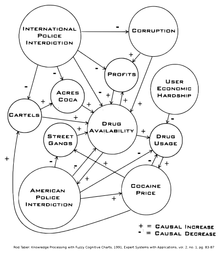This article may be too technical for most readers to understand. (December 2017) |

A fuzzy cognitive map (FCM) is a cognitive map within which the relations between the elements (e.g. concepts, events, project resources) of a "mental landscape" can be used to compute the "strength of impact" of these elements. Fuzzy cognitive maps were introduced by Bart Kosko.[1][2] Robert Axelrod introduced cognitive maps as a formal way of representing social scientific knowledge and modeling decision making in social and political systems, then brought in the computation.[3]
- ^ Bart Kosko (1986). "Fuzzy Cognitive Maps" (PDF). International Journal of Man-Machine Studies. 24: 65–75. doi:10.1016/S0020-7373(86)80040-2.
- ^ Dickerson, Julie A.; Kosko, Bart (1994). "Virtual Worlds as Fuzzy Cognitive Maps" (PDF). sipi.usc.edu. Archived from the original (PDF) on 2 September 2006. Retrieved 13 January 2022.
- ^ Axelrod, Robert (1976). Structure of Decision: The Cognitive Map of Political Elites. Princeton University Press. ISBN 978-0-691-10050-0.